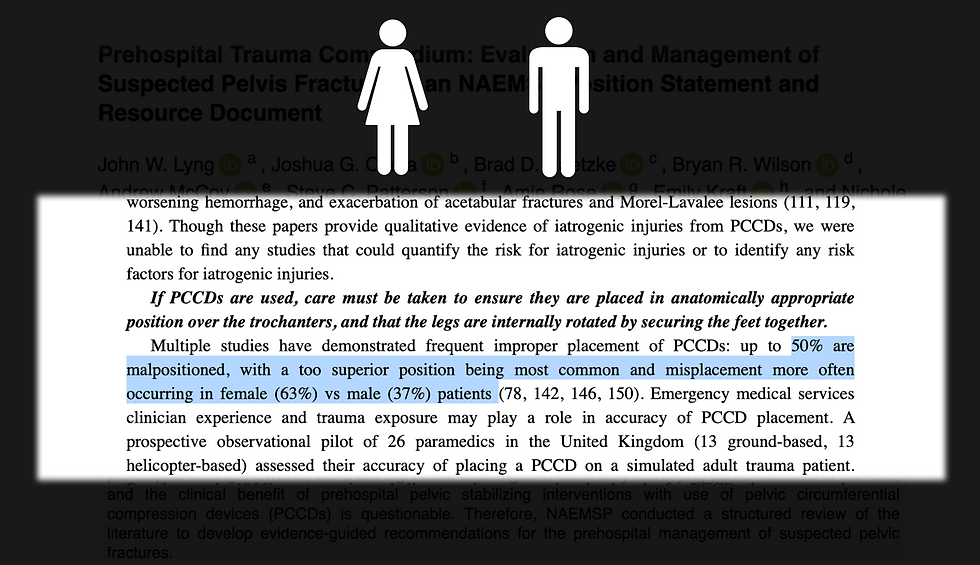Should we throw away our pelvic binders? w/ Dr. John Lyng
- foamfrat
- Aug 7
- 3 min read
Pelvic binders have long been considered a standard intervention in the management of suspected pelvic fractures in the prehospital setting. However, recent guidance from the National Association of EMS Physicians (NAEMSP) challenges some of the long-standing assumptions surrounding their use. In a recent FOAMfrat podcast episode, I spoke with Dr. John Lyng(@JLyingEMSMD), editor-in-chief of the NAEMSP Trauma Compendium, to explore the evidence and rationale behind their newly released position statement on pelvic fracture management.
The Background
The pelvic binder position statement is one of 18 evidence-based papers within the broader NAEMSP Trauma Compendium. This initiative was designed to critically appraise and consolidate best practices in prehospital trauma care, especially for areas previously guided more by tradition than by data.
Dr. Lyng and his colleagues sought to answer three fundamental questions:
Do pelvic fractures cause life-threatening hemorrhage?
Does the application of a pelvic binder improve clinical outcomes?
Are we applying them appropriately in the field?
Key Findings from the Literature Review
Pelvic Fractures Are Rarely the Primary Source of Hemorrhage
While pelvic fractures are associated with bleeding, they are seldom the primary cause of hemorrhagic shock. The literature suggests that most hypotensive trauma patients with pelvic fractures are bleeding from other sites—such as the abdomen (e.g., spleen or liver injuries) or from external sources—not from peri-pelvic vascular injuries.
Limited Evidence of Clinical Benefit from Pelvic Binders
Despite their widespread use, there is no conclusive evidence that pelvic binders improve key patient outcomes, including:
Mortality
Volume of blood products required
Hospital length of stay
ICU duration
Need for surgical or interventional radiology procedures
This finding holds even in cases where the binder was applied correctly.
Improper Application is Common—and Potentially Harmful
Field studies reveal that pelvic binders are often placed too high (over the iliac crest rather than the greater trochanters). Misplacement may worsen certain fracture patterns—particularly lateral compression fractures—by increasing deformity and potentially exacerbating bleeding.

Mechanism-Based Application: A Cautionary Note
The practice of applying pelvic binders based solely on the mechanism of injury (e.g., motor vehicle collisions, pedestrian struck, falls from height) is being reconsidered. The team emphasizes the importance of avoiding empirical application without objective signs of pelvic instability or hemodynamic compromise.
Scoring Tools May Help Identify the Right Patients
One promising development is the Pelvic Vascular Injury Score, which uses prehospital-accessible criteria such as:
Age >70
Shock index >1
High-energy mechanism
CPR or significant fluid resuscitation
Use of vasopressors
A score of 6 or higher was associated with a high likelihood of an actual pelvic vascular injury. While not widely adopted yet, tools like this may help guide more targeted and appropriate use of binders.
Clinical Practice Implications
Reconsider Routine Use. The NAEMSP explicitly states that "prehospital use of pelvic circumferential compression devices should be reconsidered, given lack of proven clinical benefit and the potential for iatrogenic harm."
If Used, Apply Correctly
Position low over the greater trochanters—not the iliac crests
Internally rotate and bind the legs together to reduce pelvic volume

Avoid application in suspected lateral compression fractures
Prioritize Hemorrhage Source Identification In hypotensive trauma patients, do not anchor the diagnostic and therapeutic approach solely on the presence of a pelvic fracture. Continued search for intra-abdominal, thoracic, or external bleeding is essential.
The new NAEMSP position statement encourages the EMS community to reassess the role of pelvic binders through a more evidence-based lens. While pelvic binders may still have a role in select cases, their routine application without clear indications may not only be ineffective, but potentially harmful.
Providers and medical directors are encouraged to:
Review the full open-access paper
Audit current training and application practices
Engage in thoughtful discussion on protocol updates
Access the Full Statement📄 NAEMSP Position Statement on Prehospital Management of Pelvic Fractures. Available open-access via Prehospital Emergency Care: Read it here




